Mountain Climbing in Bhutan: A Unique Adventure in the Land of the Thunder Dragon
Bhutan, also known as the Land of the Thunder Dragon, is a small and isolated country located in the eastern Himalayas. This kingdom has a unique culture and history that has been preserved for centuries, making it a fascinating destination for tourists from all over the world. One of the most exciting activities to do in Bhutan is mountain climbing, as the country has some of the highest peaks in the world, including Gangkhar Puensum, the highest peak in Bhutan and the highest unclimbed peak in the world. In this article, we will conduct you through everything you need to know about mountain climbing with local private English-speaking mountain guides in Bhutan.
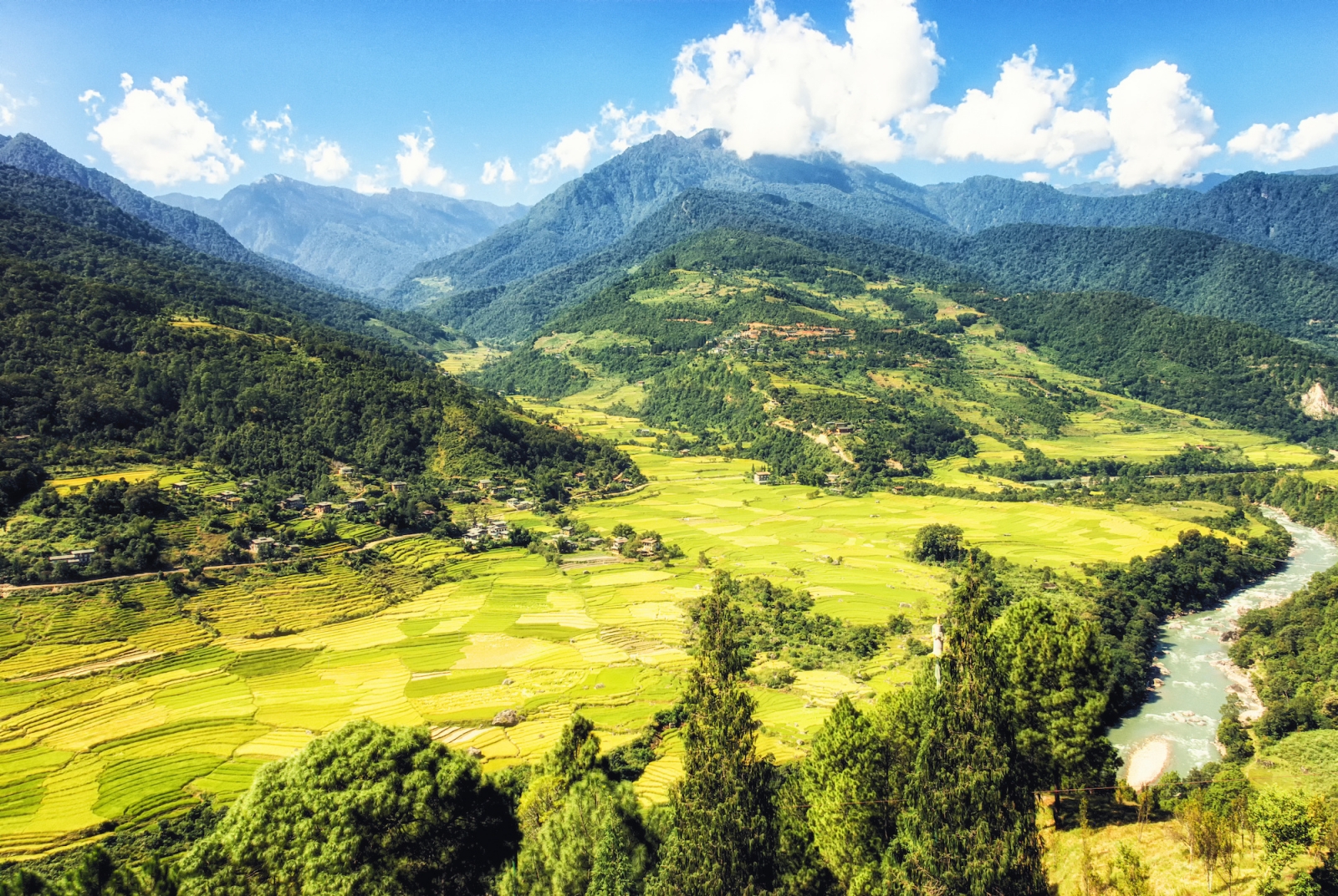
The Paro River is a major river that flows through the Paro Valley in Bhutan. It originates from the northern slopes of the Himalayas and flows through the western part of Bhutan before joining the Wang Chhu (river) near the capital city of Thimphu.
The Paro River is an important source of irrigation for the farms and terraced fields in the Paro Valley, which is known for its agricultural production of rice, wheat, maize, and other crops. The river is also a popular destination for adventure enthusiasts who enjoy kayaking and rafting on its rapids.
The Paro River is surrounded by scenic landscapes and dotted with numerous monasteries and temples, including the famous Paro Taktsang (Tiger's Nest) monastery, which is perched on a cliff overlooking the river. The river is also a habitat for various species of fish, including trout and mahseer.
Overall, the Paro River is an important natural resource in Bhutan, providing water for agriculture and serving as a popular destination for adventure and tourism. Its stunning scenery and cultural significance make it an important part of Bhutan's natural and cultural heritage.
The History of Bhutan
Bhutan has a rich and complex history that dates back to ancient times. The country was first unified in the 17th century by Zhabdrung Ngawang Namgyel, who is considered the father of modern Bhutan. Since then, Bhutan has been ruled by a monarchy, and its culture and traditions have been preserved through the centuries. In 2008, Bhutan transitioned to a democratic constitutional monarchy, and it has since become a model for sustainable development and environmental conservation.
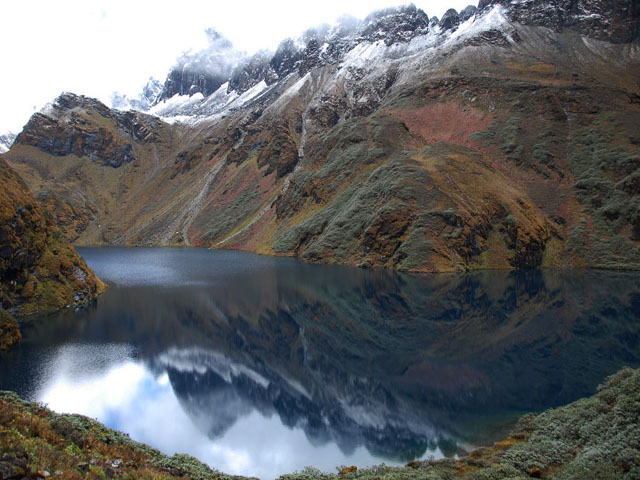
Bhutan is a small country with a population of around 750,000 people. Its economy is based on agriculture, forestry, and tourism. Bhutan is known for its Gross National Happiness (GNH) philosophy, which prioritizes the well-being of its citizens over economic growth. Bhutan is also famous for its stunning natural landscapes, rich culture and traditions, and commitment to environmental conservation.
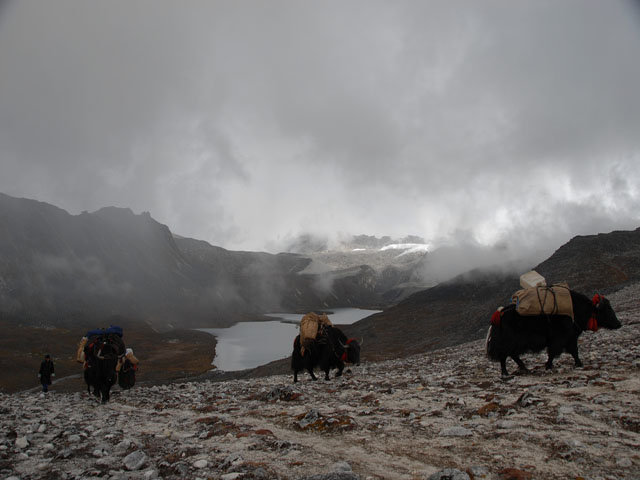
Bhutan's unique culture and natural beauty make it an attractive destination for tourists. The country has a policy of high-value, low-impact tourism, which means that tourists have to pay a minimum daily fee to enter the country. This fee covers accommodation, food, transportation, and a local licensed tour guide in Bhutan, ensuring that tourists have a high-quality experience and that tourism benefits the local community. Bhutan is also known for its rich biodiversity, including rare and endangered species such as the snow leopard and the black-necked crane.
Famous Mountain Climbing Routes in Bhutan
Bhutan has some of the highest and most challenging peaks in the world, including Gangkhar Puensum, Jhomolhari, and Jitchu Drake. These peaks attract experienced climbers from all over the world. Most mountain climbing in Bhutan is done with the assistance of local private English-speaking mountain guides, who provide logistical support and ensure the safety of climbers. Some of the most popular mountain climbing routes in Bhutan include the Jhomolhari Trek, the Laya-Gasa Trek, and the Snowman Trek.
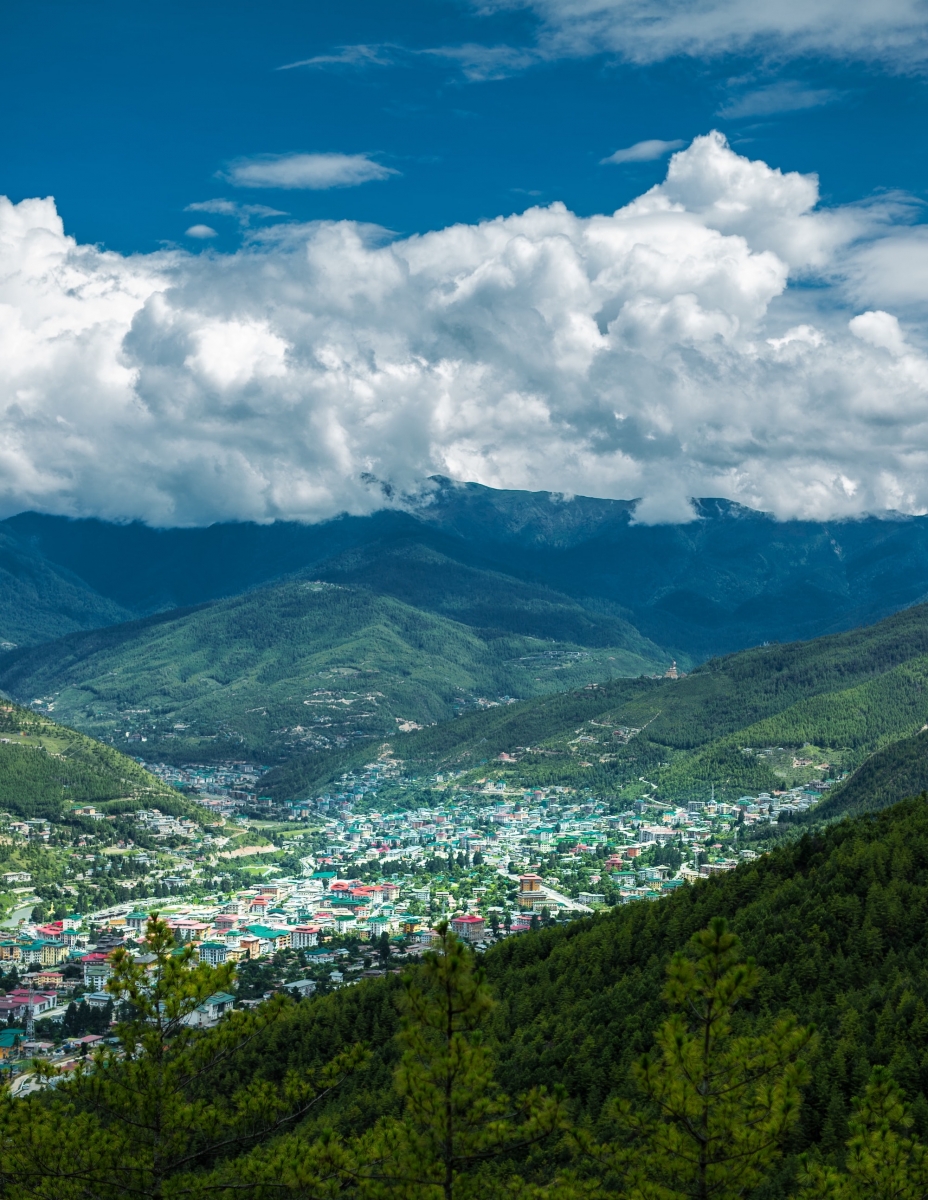
Thimphu city is the capital and largest city of Bhutan, located in the western part of the country. It has a population of around 100,000 people and is situated at an altitude of 2,320 meters above sea level. The city is known for its stunning natural beauty, rich cultural heritage, and unique blend of traditional and modern lifestyles.
Thimphu is home to several significant landmarks and tourist attractions, including the Tashichho Dzong, a beautiful fortress that serves as the seat of Bhutan's government and religious institutions. Another popular site is the Buddha Dordenma statue, a massive bronze statue of Buddha that stands over 50 meters tall and can be seen from many parts of the city.
The city also boasts several museums and galleries, including the National Folk Heritage Museum, the Textile Museum, and the Voluntary Artists' Studio in Thimphu, which showcases the work of contemporary Bhutanese artists. Thimphu is also known for its vibrant local markets, where visitors can shop for traditional crafts, textiles, and souvenirs.
In addition to its cultural attractions, Thimphu is surrounded by breathtaking natural scenery, including lush forests, sparkling rivers, and snow-capped mountains. Visitors can take scenic hikes and treks in the surrounding hills, or visit nearby natural parks such as the Jigme Dorji National Park and the Phajoding Nature Reserve.
Local individual mountain guides in Bhutan play a crucial role in organizing and accompanying tourists during mountain climbing in Bhutan. They provide logistical support, including transportation, equipment rental, and accommodation, and ensure the safety of climbers. They also serve as cultural ambassadors, sharing their knowledge and expertise about Bhutan's culture and traditions with tourists.
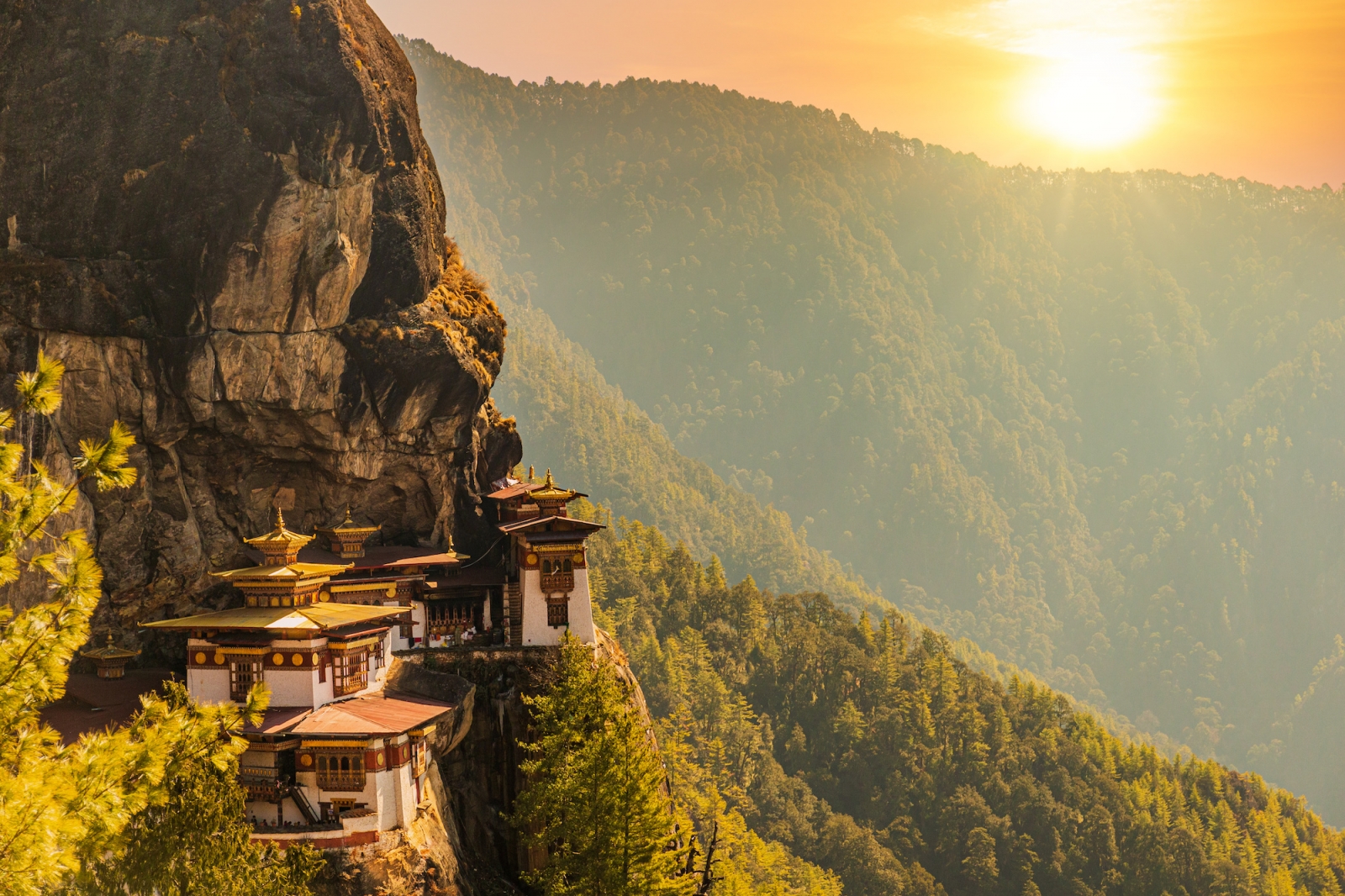
Taktsang Palphug Monastery, also known as the Tiger's Nest Monastery, is a prominent Buddhist sacred site located in the Paro Valley of Bhutan. It is one of the most iconic and popular tourist destinations in Bhutan and is considered a must-visit for anyone traveling to the country.
The monastery is perched on a steep cliff, approximately 3,120 meters (10,240 feet) above sea level. According to legend, Guru Rinpoche, the founder of Tibetan Buddhism, flew to this location on the back of a tiger in the 8th century and meditated in a cave there for three months. The monastery was later built around the cave and has become an important pilgrimage site for Buddhists from all over the world.
To reach the Tiger's Nest Monastery, visitors must hike a steep and challenging trail that takes about 2-3 hours each way. Along the way, there are several viewpoints where hikers can rest and take in the stunning views of the surrounding mountains and valleys.
The monastery itself is a remarkable sight, with intricately carved wooden pillars, colorful frescoes, and golden statues. Visitors can explore the various temples, prayer rooms, and courtyards, and learn about the history and significance of the monastery from local guides.
Visitors to the Tiger's Nest Monastery should dress modestly and respectfully, and be prepared for a challenging hike at a high altitude. The monastery is open daily from 8:00 am to 1:00 pm and from 2:00 pm to 5:00 pm. Photography is allowed, but flash photography is not permitted inside the monastery.
Mountain hiking in Bhutan can be expensive due to the country's policy of high-value, low-impact tourism. The minimum daily fee for tourists is set by the government and covers accommodation, food, transportation, and a licensed tour guide. The fee varies depending on the season and the type of accommodation, but it usually ranges from $200 to $250 per person per day.
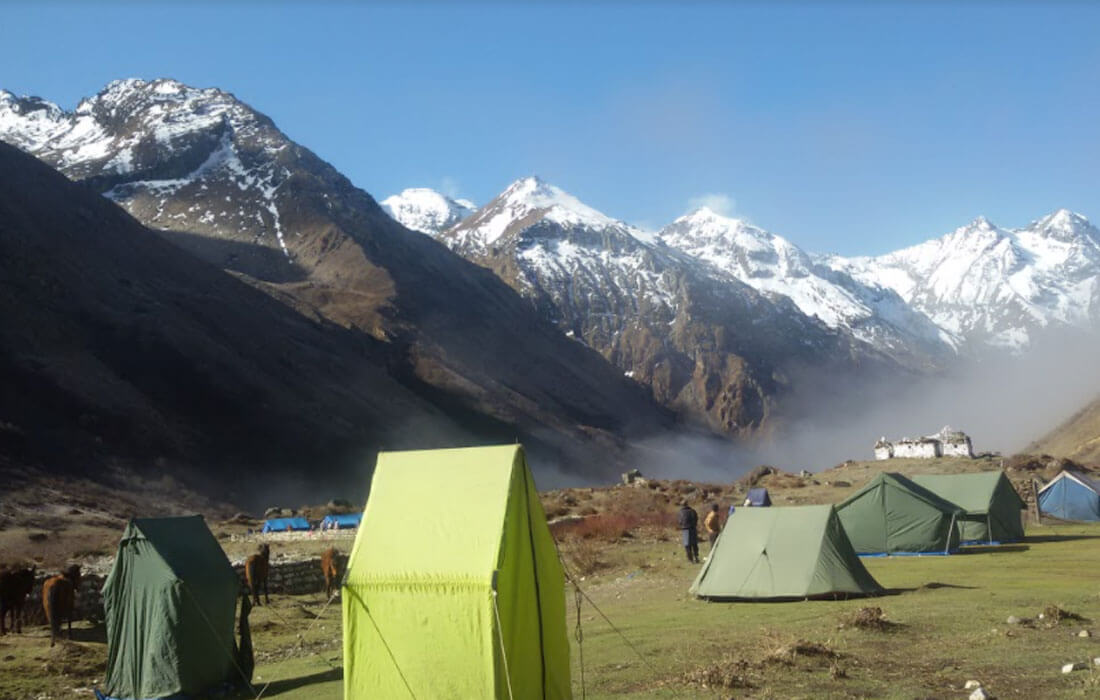
Typical base camping on the Jumolhari trek in Bhutan
Jomolhari Trek
The Jomolhari Trek is one of the most popular trekking routes in Bhutan. This trek takes you to the base camp of Jomolhari, the second-highest peak in Bhutan. The trek starts from Paro and takes you through beautiful forests, pastures, and remote villages. You'll cross several high passes, including the highest pass on the trek, the Nyile La pass at an elevation of 4,890 meters. The trek is usually completed in 8 to 10 days, depending on the itinerary.
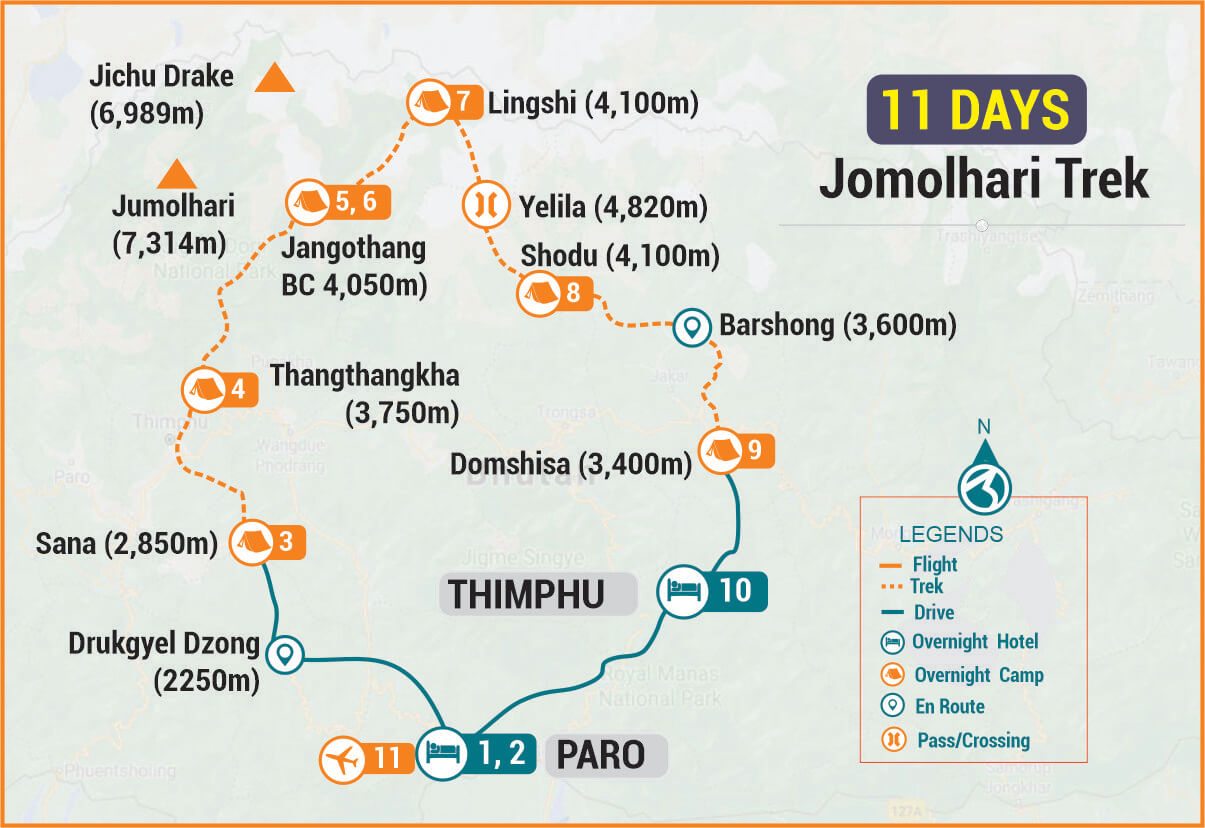
Laya-Gasa Trek
The Laya-Gasa Trek is another popular trekking route in Bhutan. This trek takes you through some of the most remote and pristine areas of Bhutan. You'll start the trek in Paro and trek through beautiful forests and valleys, past high mountain passes, and remote villages. The highlight of the trek is the village of Laya, a beautiful village perched on a hillside at an elevation of 3,800 meters. You'll also get to see some of Bhutan's stunning wildlife, including the elusive snow leopard. The trek is usually completed in 16 to 18 days, depending on the itinerary.
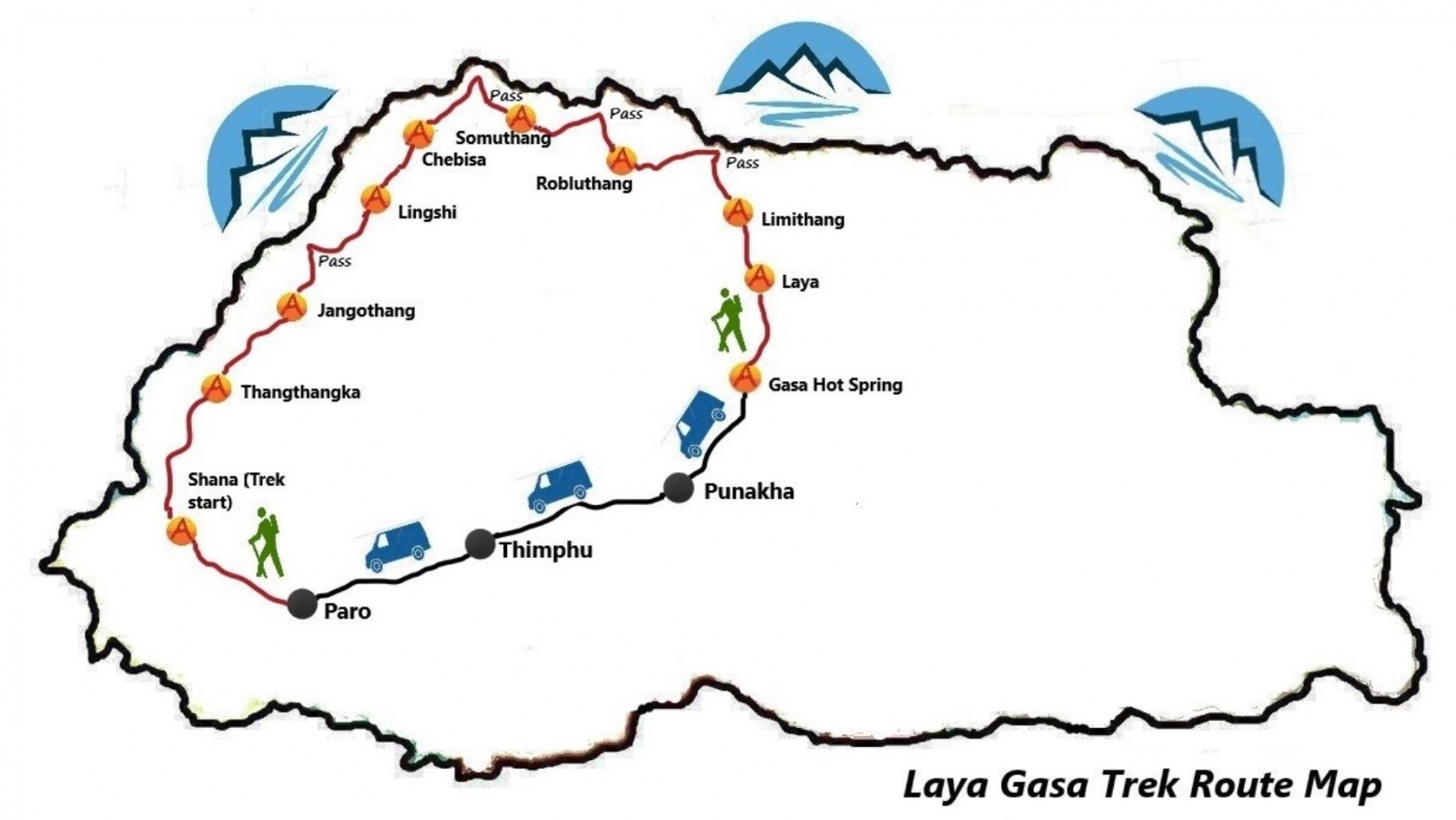
Snowman Trek:
The Snowman Trek is one of the most challenging and rewarding trekking routes in the world. This trek takes you through some of the most remote and rugged terrains in Bhutan, including several high mountain passes and glaciated peaks. The trek starts in Paro and takes you through the beautiful valleys of Thimphu and Punakha before heading into the high mountains. You'll cross several high passes, including the highest pass on the trek, the Gangla Karchung La pass at an elevation of 5,320 meters. The trek is usually completed in 25 to 30 days, depending on the itinerary.

Panorama view on the Snowman Trek in Bhutan near Rinchen Zoe La (5,200m)
Each of these treks offers a unique and unforgettable experience, taking you through some of Bhutan's most beautiful and remote landscapes. However, it's important to note that these treks are challenging and require a good level of fitness and experience. Hiring a licensed climbing instructor and experienced mountain guide is highly recommended to ensure a safe and enjoyable trekking experience.
The cost of mountain climbing with a local guide in Bhutan
The cost of services of local personal mountain guides in Bhutan varies depending on the level of support required and the duration of the climb. Generally, the cost of hiring a personal mountain guide in Bhutan ranges from $200 to $400 per day. This fee covers the guide's services, as well as the cost of transportation, equipment rental, and accommodation.
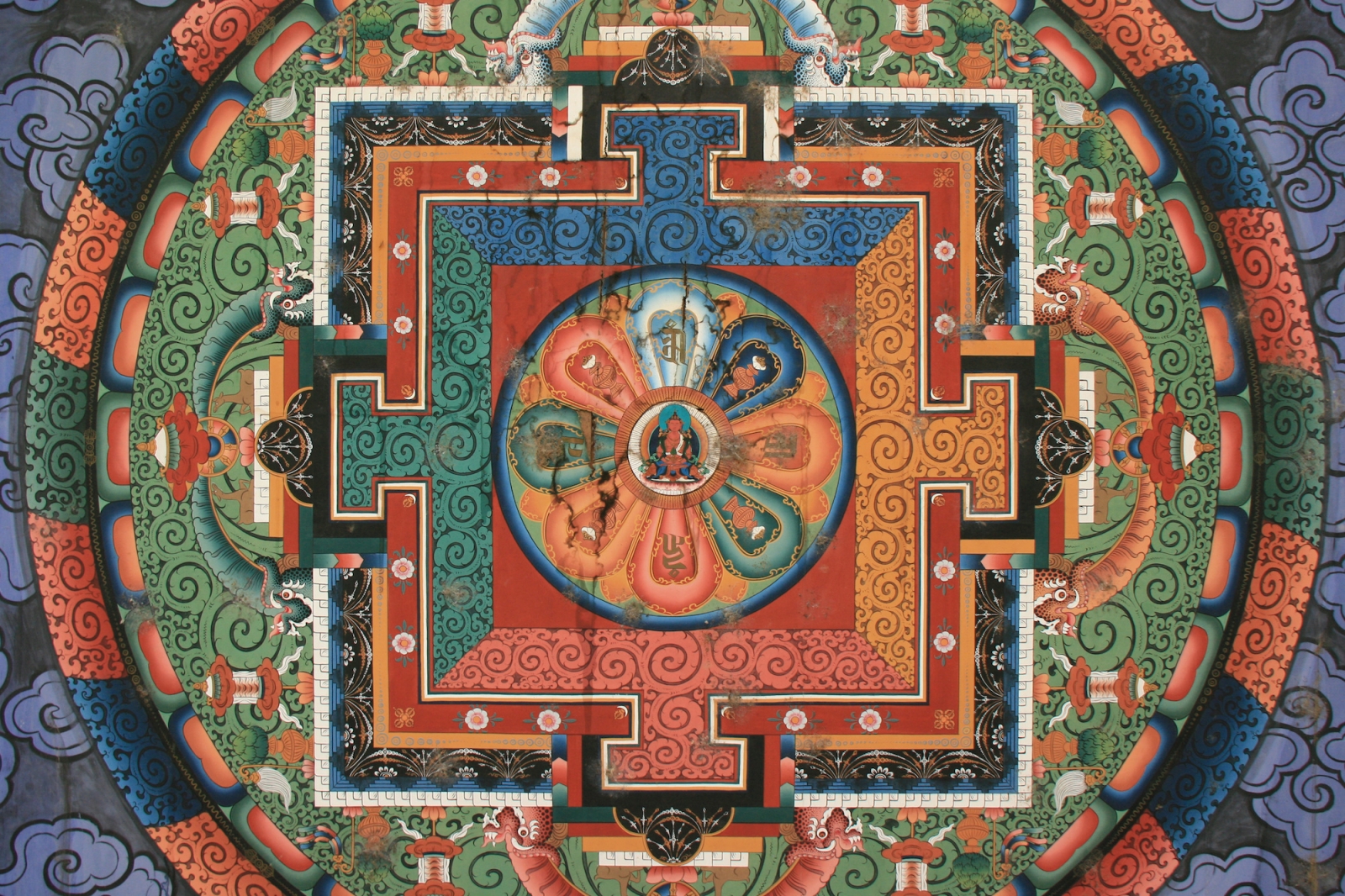
In Bhutan, the mandala refers to a symbolic circular diagram that represents the universe and the interconnectedness of all things. Mandala is a Sanskrit word that means "circle" or "center." It is an important concept in Buddhism and Hinduism and has been used in Bhutanese culture and art for centuries. In Bhutanese art, mandalas are often depicted as intricate, colorful geometric patterns with a central point. They may include various symbols and images that represent different aspects of the universe or the individual's spiritual journey. Mandalas are often used as a tool for meditation, with intricate patterns helping to focus the mind and induce a state of calm and concentration. In addition to their use in art and meditation, mandalas also play an important role in Bhutanese religious and cultural festivals. During these events, intricate mandalas are created using colored sand or grains and are often destroyed after the event as a symbol of impermanence. Mandalas are a significant part of Bhutanese culture and spirituality, representing the interconnectedness of all things and the importance of finding inner peace and harmony.
Climbing mountains in Bhutan requires a permit from the government, which can only be obtained through licensed tour organizers. Climbers are also required to follow strict rules and conditions, including respecting the environment, avoiding damage to cultural and religious sites, and minimizing the impact on local communities. Climbers are also required to have the necessary skills and experience to climb at high altitudes, as well as adequate equipment and clothing.
Mountain climbing in Bhutan requires a high level of physical fitness and experience, as it involves challenging and technical climbs in high-altitude environments. As a result, it is generally recommended that tourists have prior experience in mountain climbing and are in good physical condition before attempting to climb in Bhutan. In addition to prior experience, it's also important that tourists are prepared for the high-altitude environment, as Bhutan's mountains can reach elevations of over 7,000 meters. Altitude sickness is a serious concern at these high elevations, and tourists should be prepared to acclimatize properly before attempting any climbs.
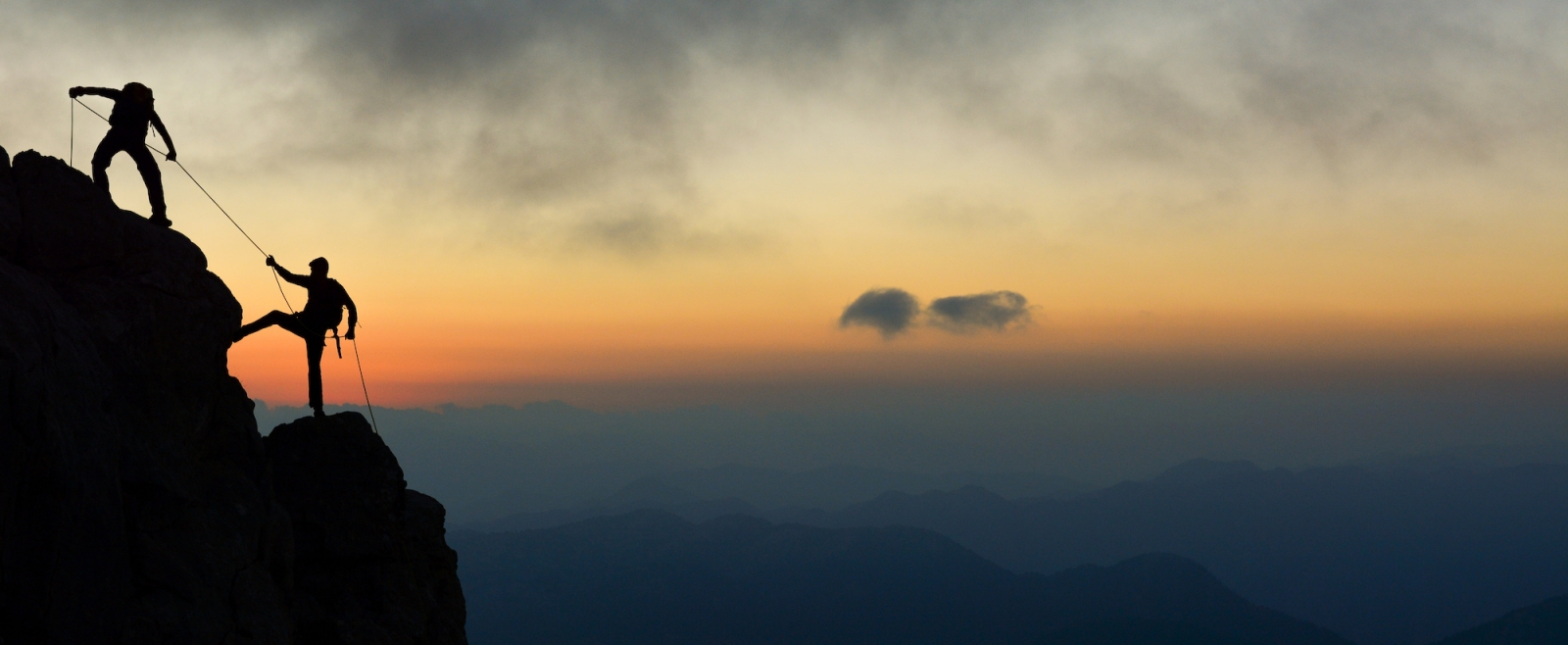
It's also important to note that climbing in Bhutan is regulated by the government, and all climbers must be accompanied by a licensed guide. These licensed guides are experienced in Bhutan's mountain environment and can provide invaluable assistance and guidance throughout the climb. Tourists who are considering mountain climbing in Bhutan should have prior experience in mountain climbing, be in good physical condition, and be prepared for the high-altitude environment. They should also be accompanied by a licensed mountain guide and prepared to follow all regulations and safety procedures set by the government.
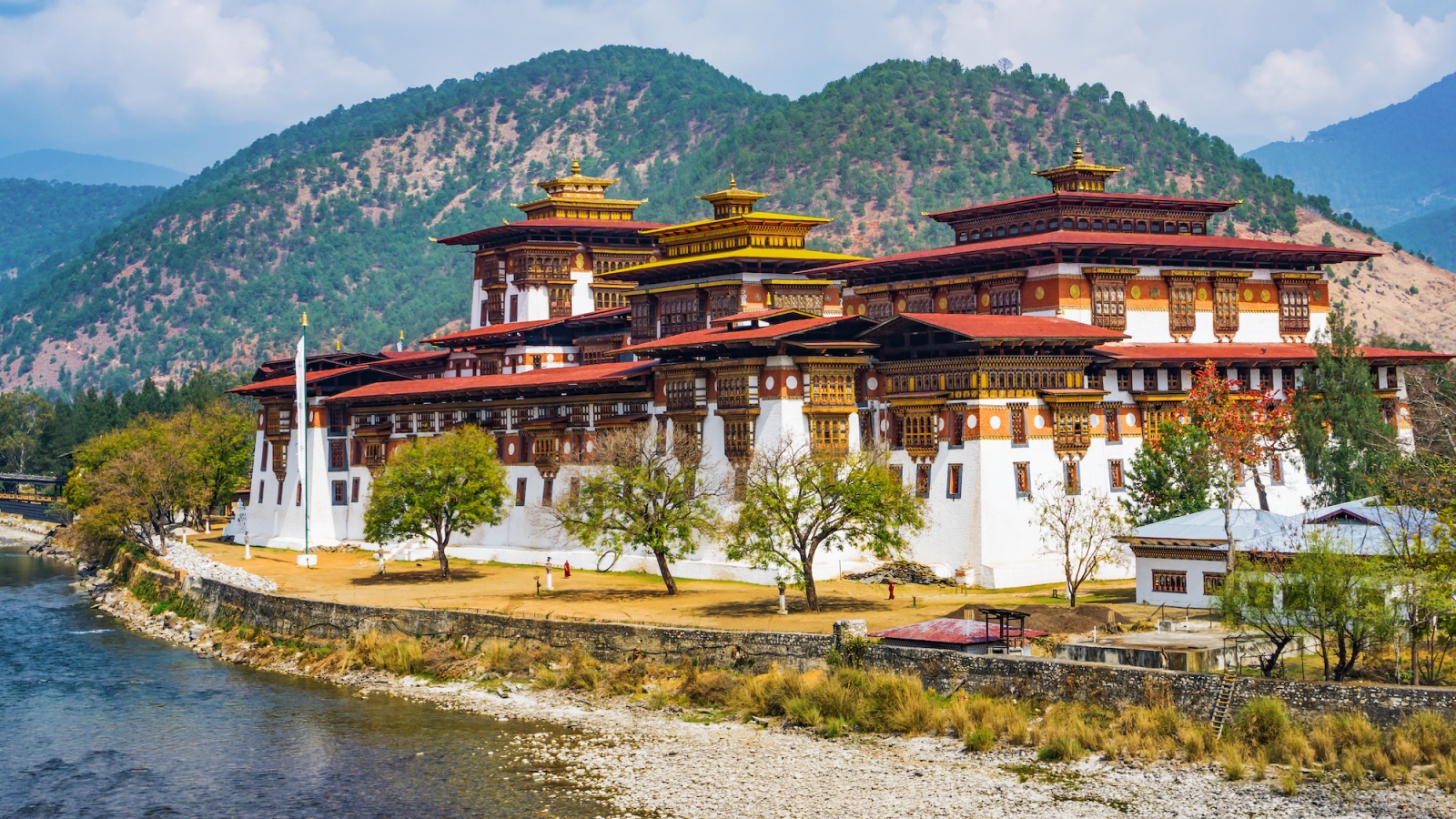
Punakha Dzong is a stunning monastery located in Punakha, the former capital of Bhutan. It is also known as the "Palace of Great Happiness" or the "Punakha Dzong Fortress". The monastery was built in 1637 and has served as the winter residence of the Bhutanese monastic body and the administrative headquarters of the Punakha district.
The Punakha Dzong is situated at the confluence of two rivers, the Pho Chhu and Mo Chhu. The location was chosen because of its strategic importance for defense purposes. The dzong has survived several earthquakes, fires, and floods, and is considered one of the most well-preserved dzongs in Bhutan.
The architecture of the Punakha Dzong is a blend of Bhutanese and Tibetan styles, with towering whitewashed walls, red-roofed buildings, and ornate golden details. The dzong houses numerous courtyards, temples, and shrines, as well as a vast collection of Buddhist artifacts, paintings, and scriptures.
One of the most famous events that take place at the Punakha Dzong is the annual Punakha Tshechu festival, which is held in late winter or early spring. This festival is a colorful celebration of Bhutanese culture and religion, featuring traditional dances, music, and rituals.
Overall, the Punakha Dzong is a must-see destination in Bhutan for anyone interested in history, culture, and spirituality.
The Best Season for Mountain Climbing in Bhutan
The best season for mountain climbing in Bhutan is from October to May when the weather is dry and clear. However, some peaks are accessible only during certain months, so it's important to check with a licensed tour leader before planning a climb.
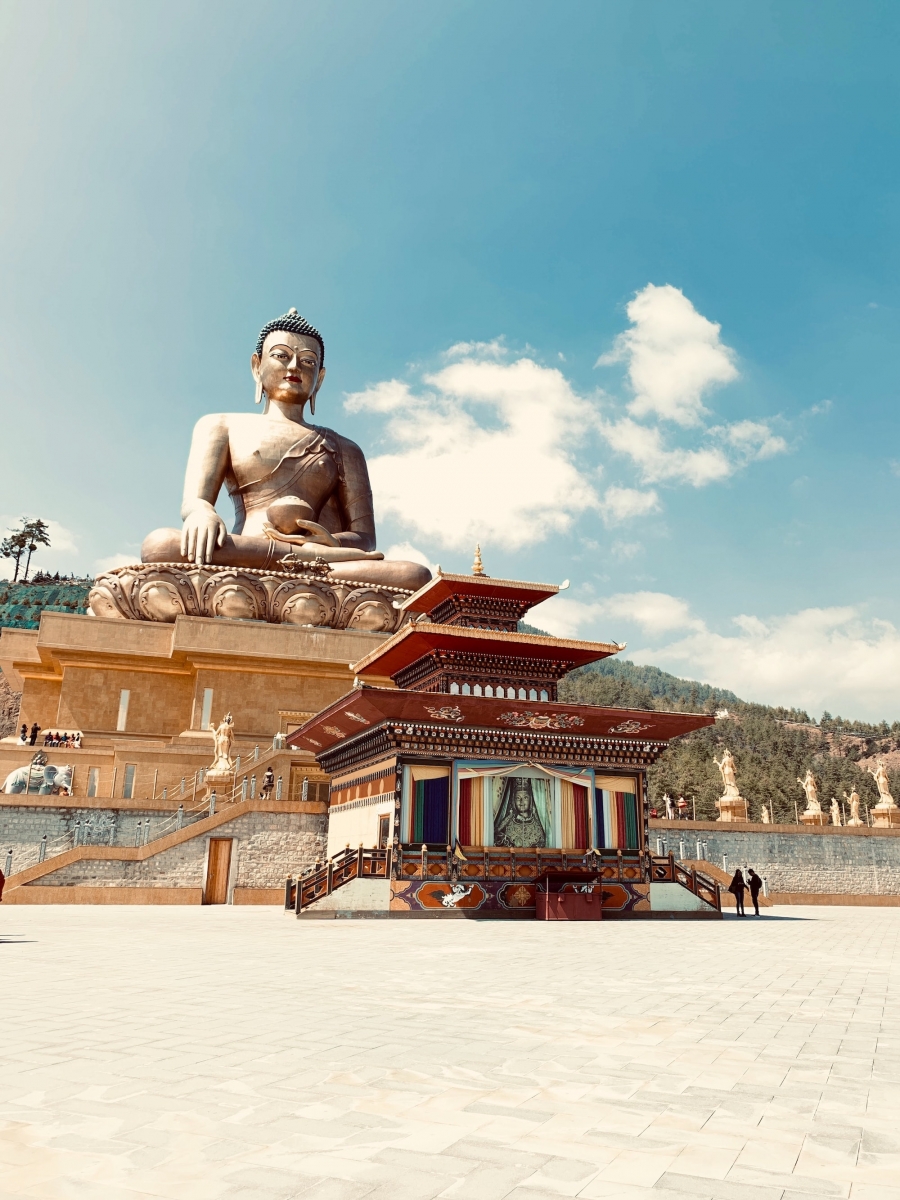
The Buddha Dordenma statue in Bhutan is a gigantic statue of Shakyamuni Buddha, located on a hilltop overlooking Thimphu, the capital city of Bhutan. It stands at a height of 169 feet (51.5 meters) and is made of bronze and gilded in gold. The statue houses over 100,000 smaller Buddha statues, each of which are made of bronze and gilded in gold. It is a popular tourist attraction and a sacred site for locals, who come to offer prayers and make offerings at the base of the statue. The Buddha Dordenma statue was constructed to commemorate the centennial of the Bhutanese monarchy in 2008.
Bhutan is considered a safe country for tourists, with a low crime rate and a stable political situation. However, mountain climbing in this country can be dangerous, and climbers are advised to follow the rules and conditions set by the government and to hire experienced and licensed local mountain guides in Bhutan on the online platform Private Guide World on www.pg.world, where you can choose the qualified local mountain tour guide who speaks your language and have enough experience to accompany you for such an uneasy trip.
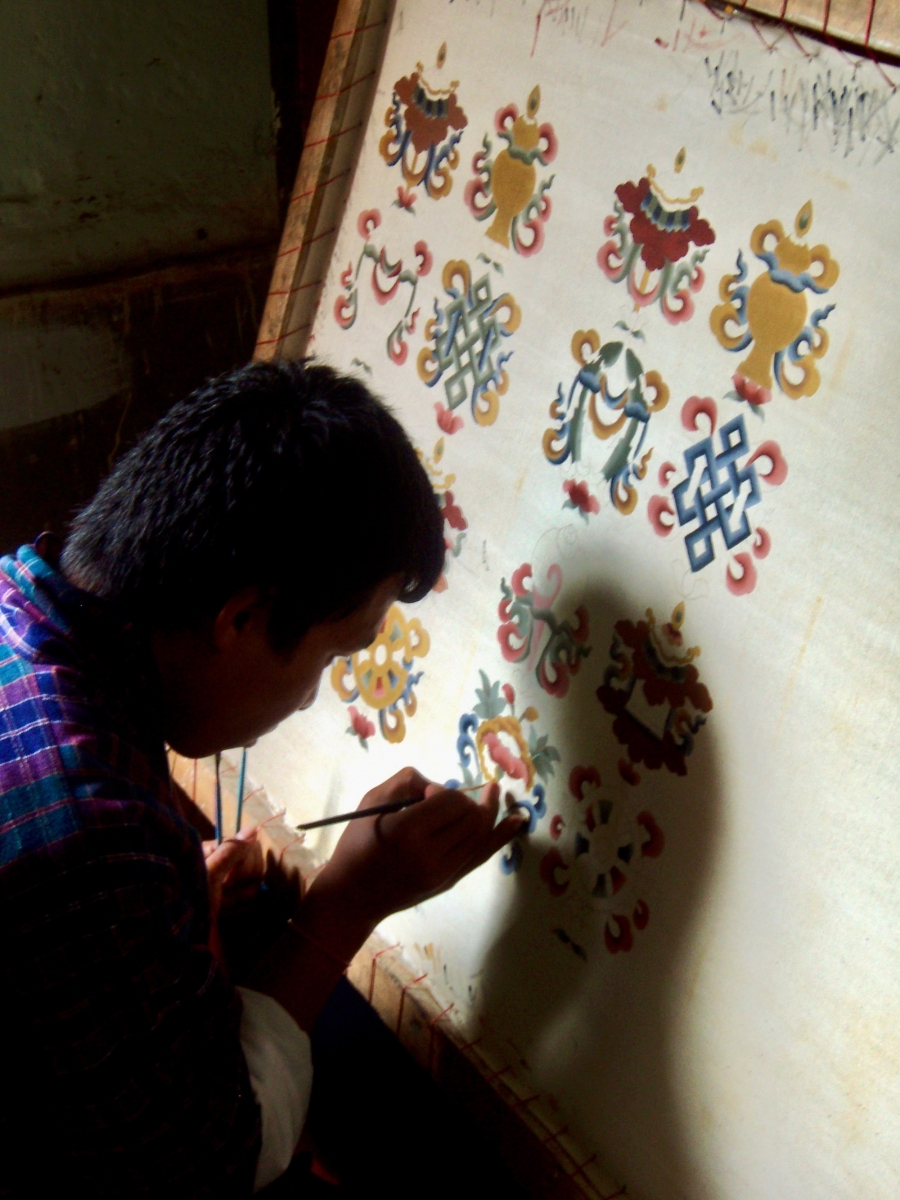
The Choki Traditional Art School is located in Kabesa Lam, Thimphu, Bhutan. It is a non-profit organization that was founded in 1999 with the goal of preserving and promoting traditional Bhutanese arts and crafts. The school provides free training to Bhutanese youth in a range of traditional arts and crafts, including painting, embroidery, sculpture, wood carving, and weaving. The students are taught by skilled master craftsmen, and they learn not only the techniques but also the cultural and historical significance of each art form. The school also provides the students with free room and board, and they are supported through donations from individuals and organizations. The Choki Traditional Art School has gained international recognition for its work in preserving Bhutanese cultural heritage, and its students have gone on to become successful artists and artisans in Bhutan and abroad.
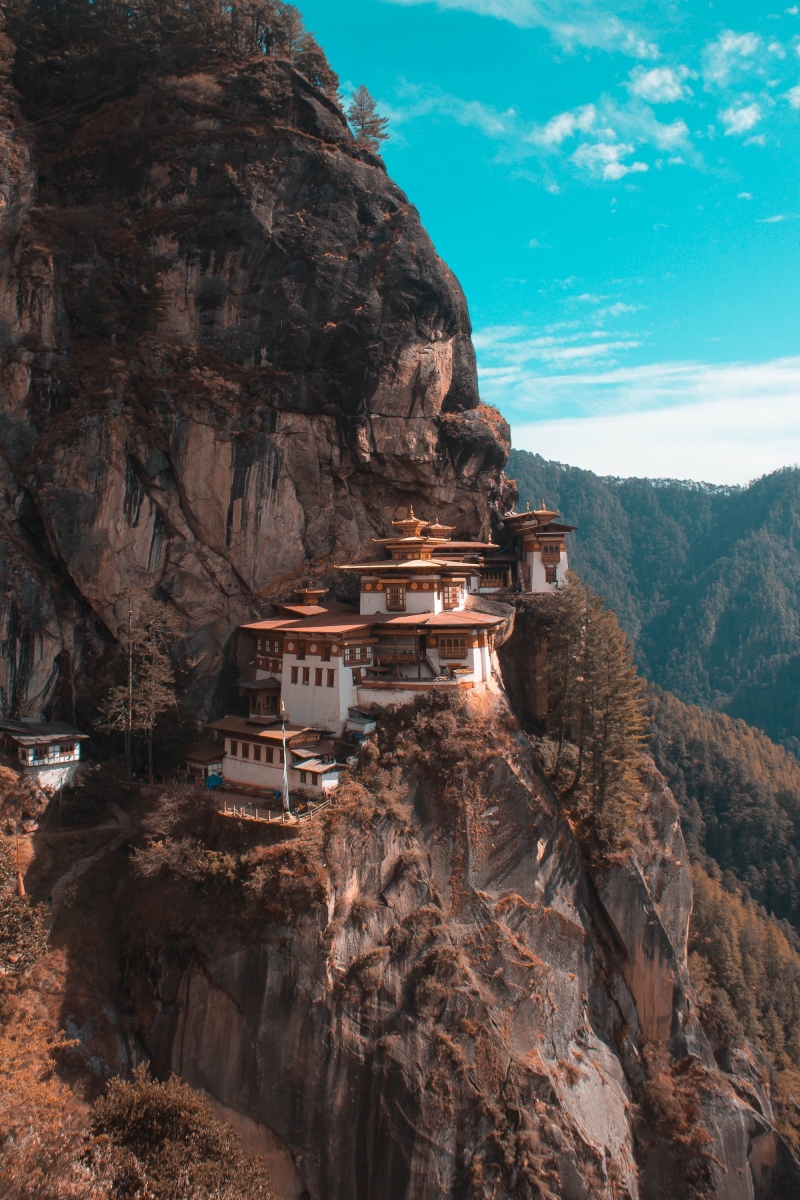
Other Attractions in Bhutan Besides Mountain Tourism
Besides mountain tourism, Bhutan has many other attractions that are worth visiting. These include cultural and religious sites such as the Tiger's Nest Monastery, the Punakha Dzong, and the Kyichu Lhakhang. Bhutan is also known for its festivals, which are held throughout the year and offer a glimpse into the country's rich culture and traditions.
Visiting tourists are encouraged to pay attention to Bhutan's cultural traditions and to respect local customs and beliefs. Some important traditions include wearing modest clothing, removing shoes before entering religious sites, and refraining from smoking or drinking alcohol in public.
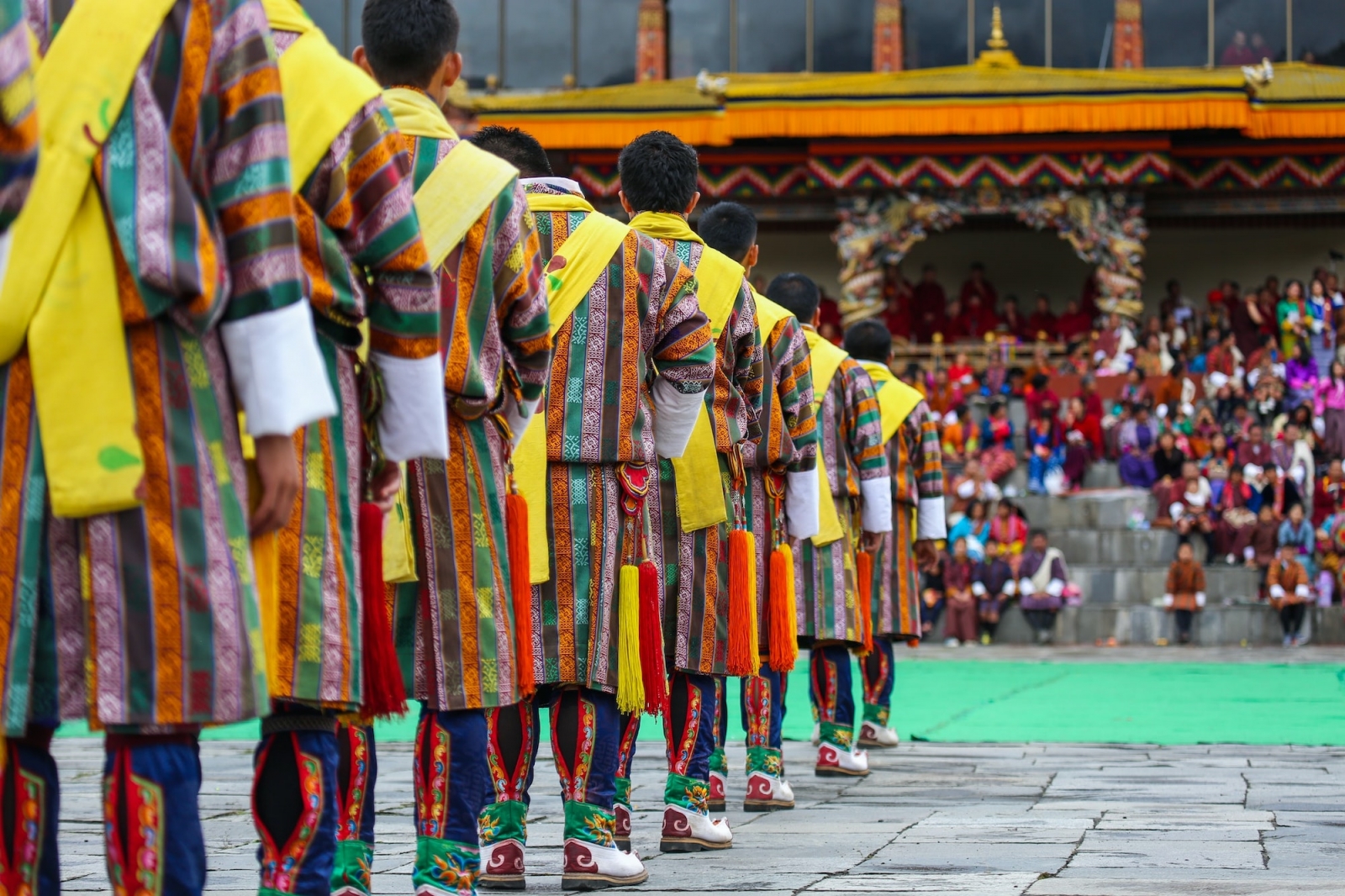
A group of male dancers gets ready for a traditional performance during the Thimphu Tshechu festival in Bhutan - it is a religious festival that takes place annually in Bhutan's capital city, Thimphu. It is one of the largest and most popular festivals in Bhutan, and it is celebrated for three days during the 8th to 10th day of the 8th lunar month of the Bhutanese calendar, which usually falls in late September or early October.
The festival is a celebration of the birthday of Guru Rinpoche, also known as Padmasambhava, who brought Buddhism to Bhutan in the 8th century. During the festival, masked dances, known as cham dances, are performed by monks and laypeople in elaborate costumes. The dances are accompanied by traditional Bhutanese music, and they depict stories from the life of Guru Rinpoche, as well as other deities and legends.
The Thimphu Tshechu is also a time for Bhutanese people to come together to celebrate their culture and socialize with family and friends. Many people dress in their finest traditional clothing, and there are also opportunities to enjoy Bhutanese food and handicrafts.
Attending the Thimphu Tshechu is a unique and immersive way to experience Bhutanese culture and religion, and it is a popular event for tourists visiting Bhutan. However, it is important to note that a festival is a religious event, and visitors should be respectful of the customs and traditions of the Bhutanese people during their visit.
Bhutan is famous for its textiles, including handwoven fabrics and intricate embroidery. Other popular souvenirs include traditional Bhutanese crafts such as wooden bowls, masks, and prayer flags. Visitors can also bring home Bhutanese tea, spices, and other food products.
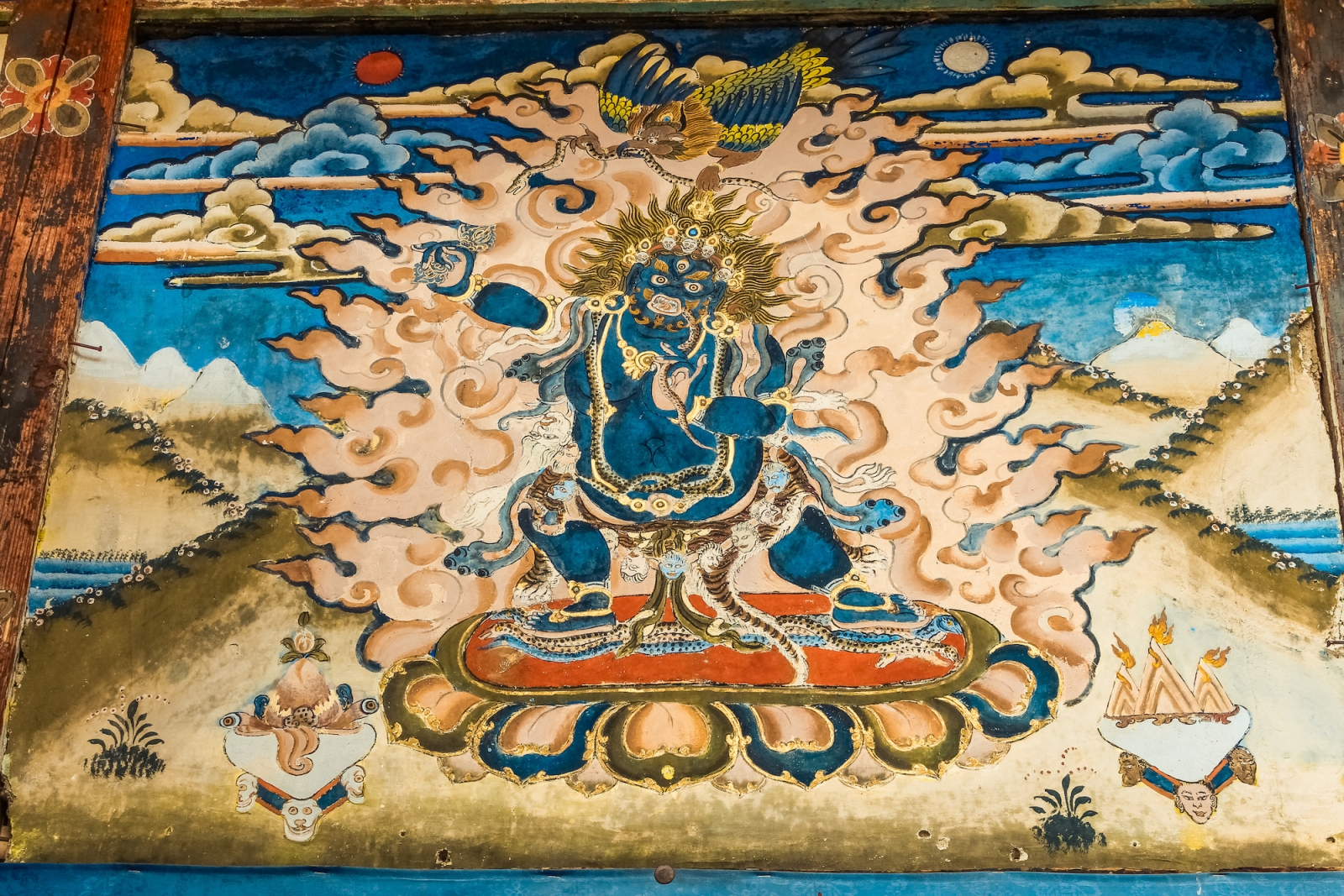
Vajrapani is a prominent figure in Tibetan Buddhism and is often depicted in tangka paintings. As a Bodhisattva, he represents the enlightened mind of the Buddha, and as Vajrapani, he embodies the power and energy of the enlightened mind. In his wrathful form, he is often depicted with a dark blue body, symbolizing the vastness of space, and with three heads and six arms. The depiction of Vajrapani in a temple in Bumthang, Bhutan would likely be a representation of the deity in his wrathful form, which is commonly seen in Tibetan Buddhism. The use of wrathful deities in Tibetan Buddhism is a way to confront and conquer negative emotions and thoughts, and transform them into positive energy. Tangka paintings are a traditional form of Tibetan Buddhist art, and they are often used in temples and monasteries as a way to depict the various deities and teachings of the religion. The use of tangka paintings in Bhutan is widespread, and it is not uncommon to see such paintings in temples and monasteries throughout the country. Overall, the depiction of Vajrapani in a temple in Bumthang in Bhutan would likely be a representation of the deity in his wrathful form, as depicted in traditional Tibetan Buddhist tangka paintings. It is a powerful symbol of the transformative power of the enlightened mind and serves as an important cultural and religious symbol in Bhutan.
Mountain climbing in Bhutan is a unique and unforgettable adventure that offers a glimpse into the country's stunning natural landscapes and rich cultural heritage. With its policy of high-value, low-impact tourism and commitment to environmental conservation, Bhutan is a responsible and sustainable destination that welcomes tourists from all over the world. Whether you're an experienced climber or a novice adventurer, Bhutan is the perfect destination for a mountain climbing expedition like no other.
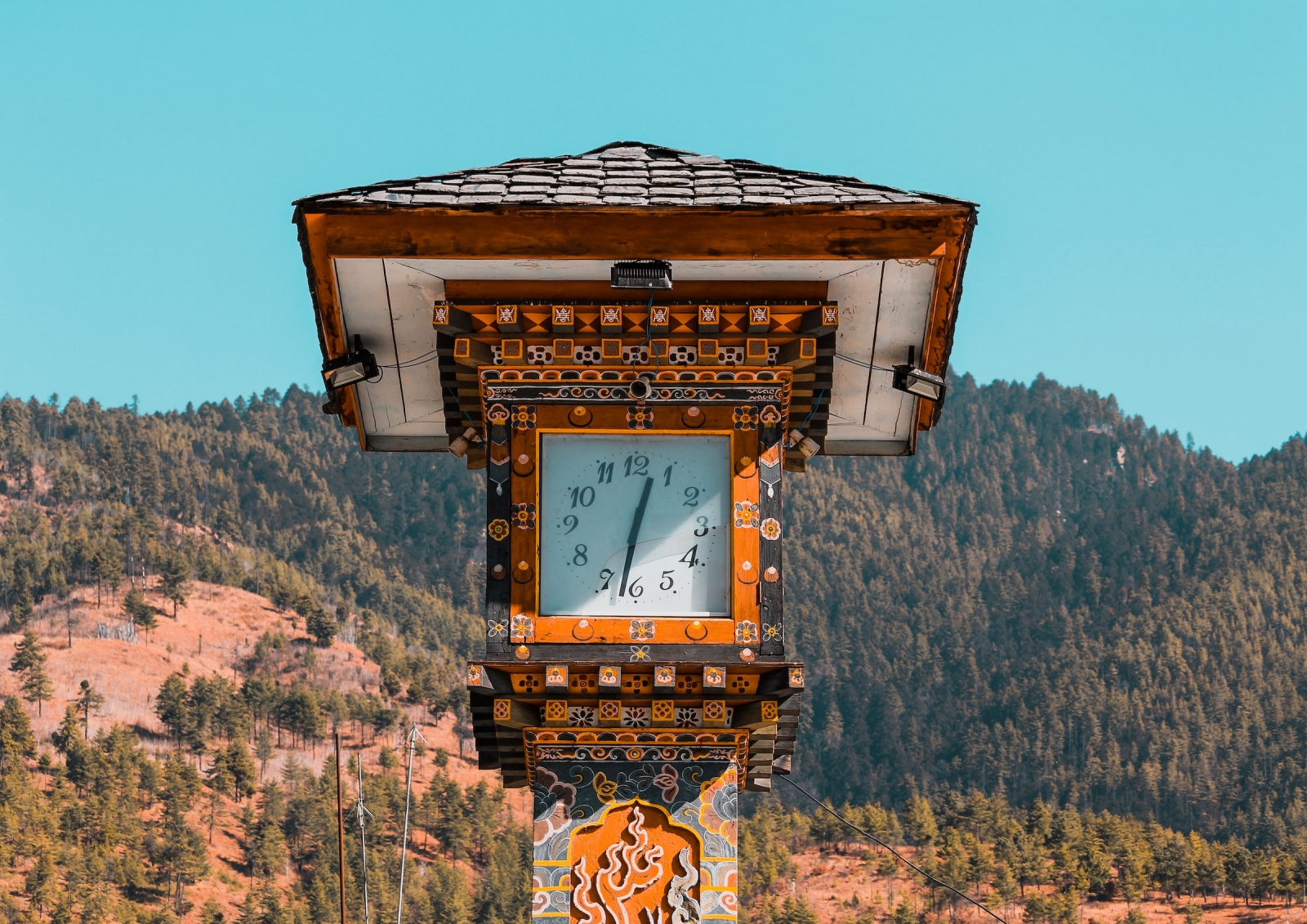
The Clock Tower Square is a popular public square located in the heart of Thimphu, the capital city of Bhutan. At the center of the square stands a tall tower that is commonly known as the Clock Tower. The tower has four clock faces, each facing a different direction, and is decorated with traditional Bhutanese architecture. The Clock Tower Square is a popular meeting place for locals and tourists alike. It's surrounded by several shops and restaurants, making it a great spot to grab a bite to eat or do some shopping. The tower also serves as a landmark in the city, making it easy for visitors to navigate around Thimphu. The Clock Tower itself is not just a timepiece, but it also houses a small museum on the top floor. The museum showcases a collection of traditional Bhutanese artifacts, including clothing, tools, and household items. Visitors can learn about the history and culture of Bhutan while enjoying panoramic views of the city from the tower's windows. The Clock Tower Square and the iconic Clock Tower are must-see attractions for visitors to Thimphu, offering a glimpse into the rich history and culture of Bhutan.
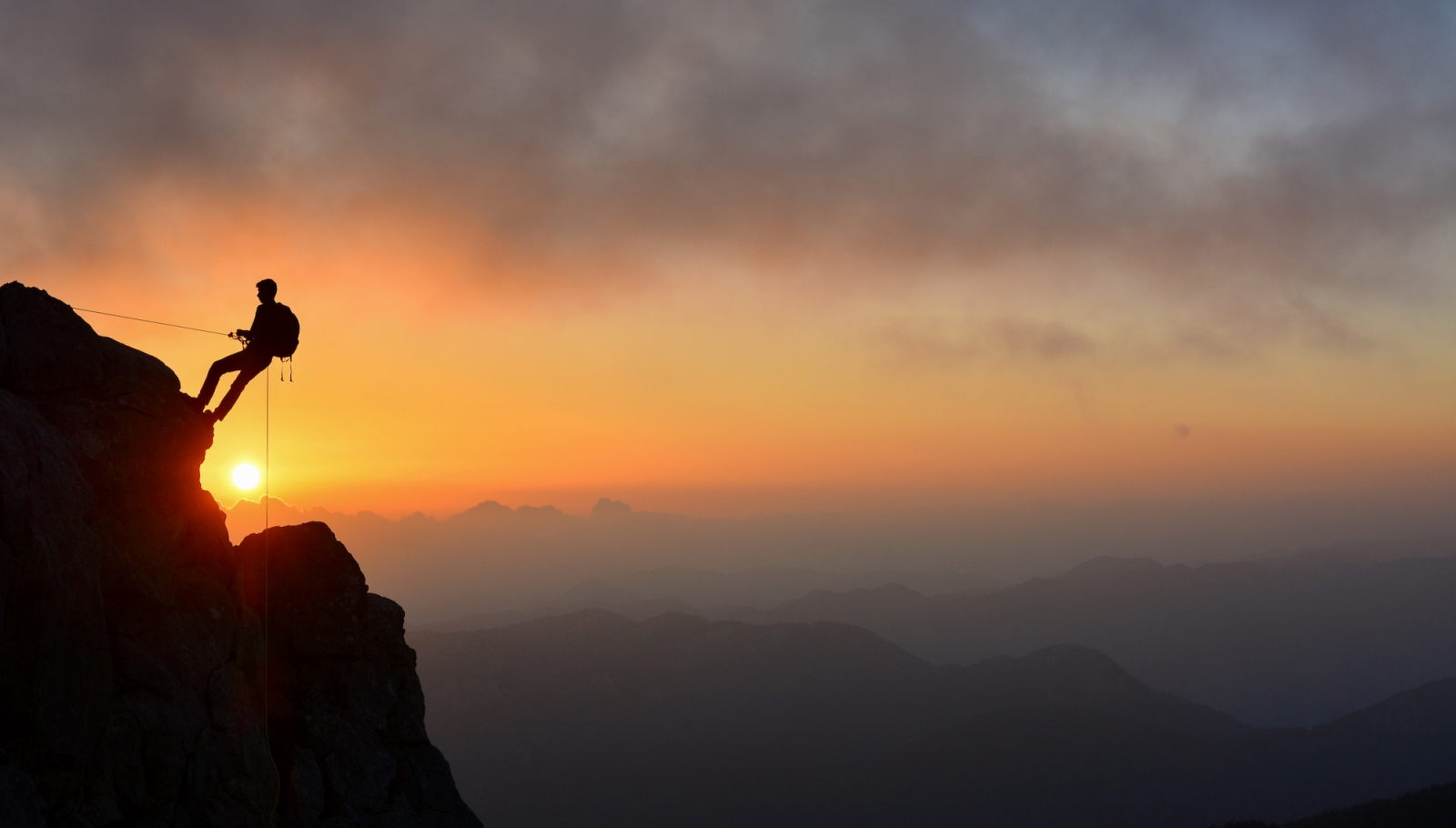
Preparation instructions for the tourists intending to climb
Tourists who are planning to go mountain climbing in Bhutan can take several steps to prepare themselves in advance. Here are some recommendations:
- Improve physical fitness: Mountain climbing in Bhutan requires a high level of physical fitness. Tourists should engage in regular physical exercises, such as cardio, strength training, and endurance activities, to prepare their bodies for the physical demands of climbing.
- Acclimate to high altitude: Bhutan's mountains can reach elevations of over 7,000 meters, and altitude sickness is a serious concern. Tourists should acclimate to high altitudes before attempting any climbs. This can be done by gradually ascending to higher elevations over several days and staying well-hydrated.
- Seek professional training: Tourists who do not have prior experience in mountain climbing should consider seeking professional training before attempting to climb in Bhutan. This can include taking a course in mountaineering, learning technical climbing skills, and practicing in a controlled environment.

- Purchase appropriate gear: Tourists should invest in appropriate climbing gear, including proper footwear, clothing, and safety equipment. It's important to choose gear that is appropriate for the specific climb and weather conditions.
- Hire a licensed guide: As mentioned earlier, all climbing in Bhutan must be accompanied by a licensed guide. Tourists should research and hire an English-speaking licensed mountain guide who has experience in Bhutan's mountain environment and can provide guidance and assistance throughout the climb.
Young teenage monks at the Thujidrag Gompa in Thimphu, Bhutan. Thudidrag Gompa is near the Phajoding Monastery - approximately 4000m above sea level.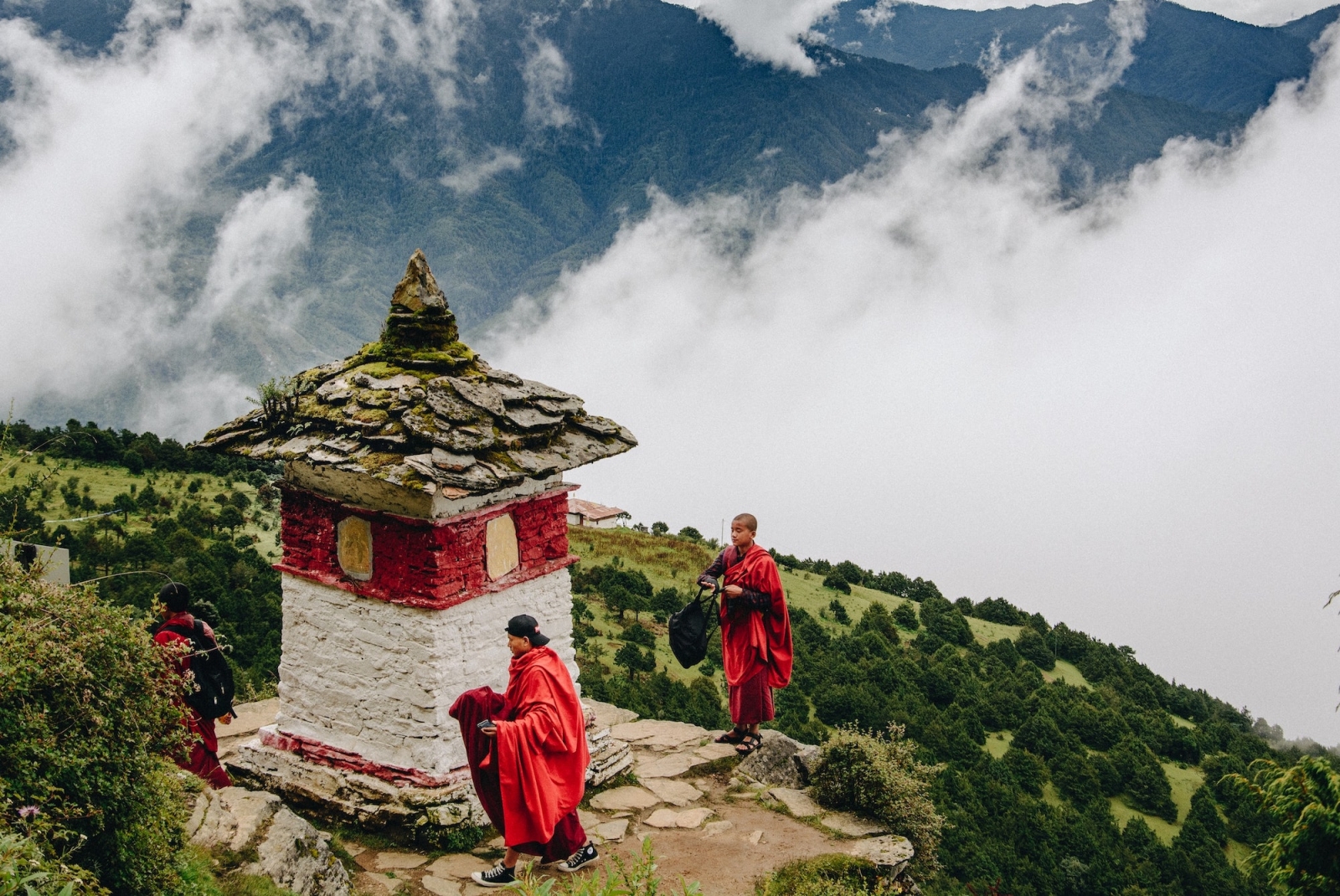
Young teenage monks at the Thujidrag Gompa in Thimphu, Bhutan. Thudidrag Gompa is near the Phajoding Monastery - approximately 4000m above sea level.
In summary, tourists who are planning to go mountain climbing in Bhutan should take steps to improve their physical fitness, acclimate to high altitudes, seek professional training, purchase appropriate gear, and hire a licensed guide. By taking these steps, tourists can prepare themselves in advance and increase their chances of having a safe and enjoyable climbing experience in Bhutan.

What equipment is required for tourists in Bhutan?
Mountain climbing in Bhutan requires specialized equipment to ensure the safety and comfort of climbers. Here are some of the equipment that tourists should bring or rent for mountain climbing in Bhutan:
- Mountaineering boots: Sturdy and insulated boots with rigid soles and high ankle support are essential for mountain climbing. They should also be waterproof and have good traction.
- Crampons: These are spikes that attach to the bottom of boots to provide additional traction on ice and snow.
- Harness and rope: These are essential safety equipment for mountain climbing. A harness is worn around the waist and legs, and a rope is used to attach climbers to each other and anchors for safety.
- Ice ax: This is a tool used to help climbers ascend and descend icy slopes.
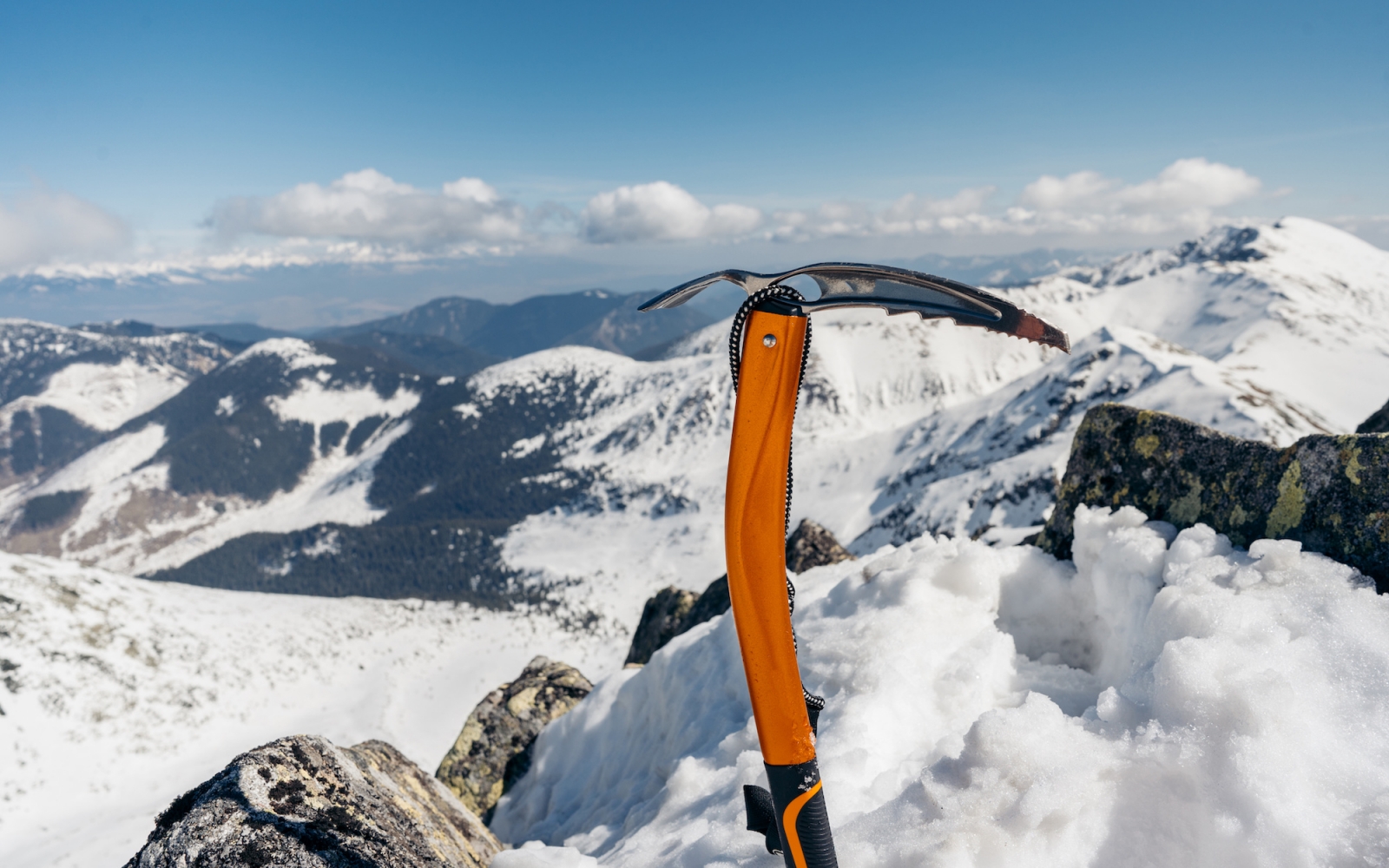
- Climbing helmet: This is essential to protect the head from falling rocks and ice.
- Warm clothing: Layered clothing is essential for mountain climbing in Bhutan, as temperatures can vary widely throughout the day. Warm and waterproof outerwear, insulated pants, gloves, and hats are also necessary.
- Backpack: A sturdy backpack is essential for carrying equipment, clothing, food, and water.
- Sunglasses: Glacier glasses or sunglasses with UV protection are necessary to protect eyes from the bright sun and snow glare.
- First aid kit: A well-stocked first aid kit with medications for altitude sickness, blisters, and other common ailments is essential.
- Water bottles and purification tablets: Clean drinking water is essential for staying hydrated during climbs. Tourists can bring their own water bottles and purification tablets to ensure access to clean water.
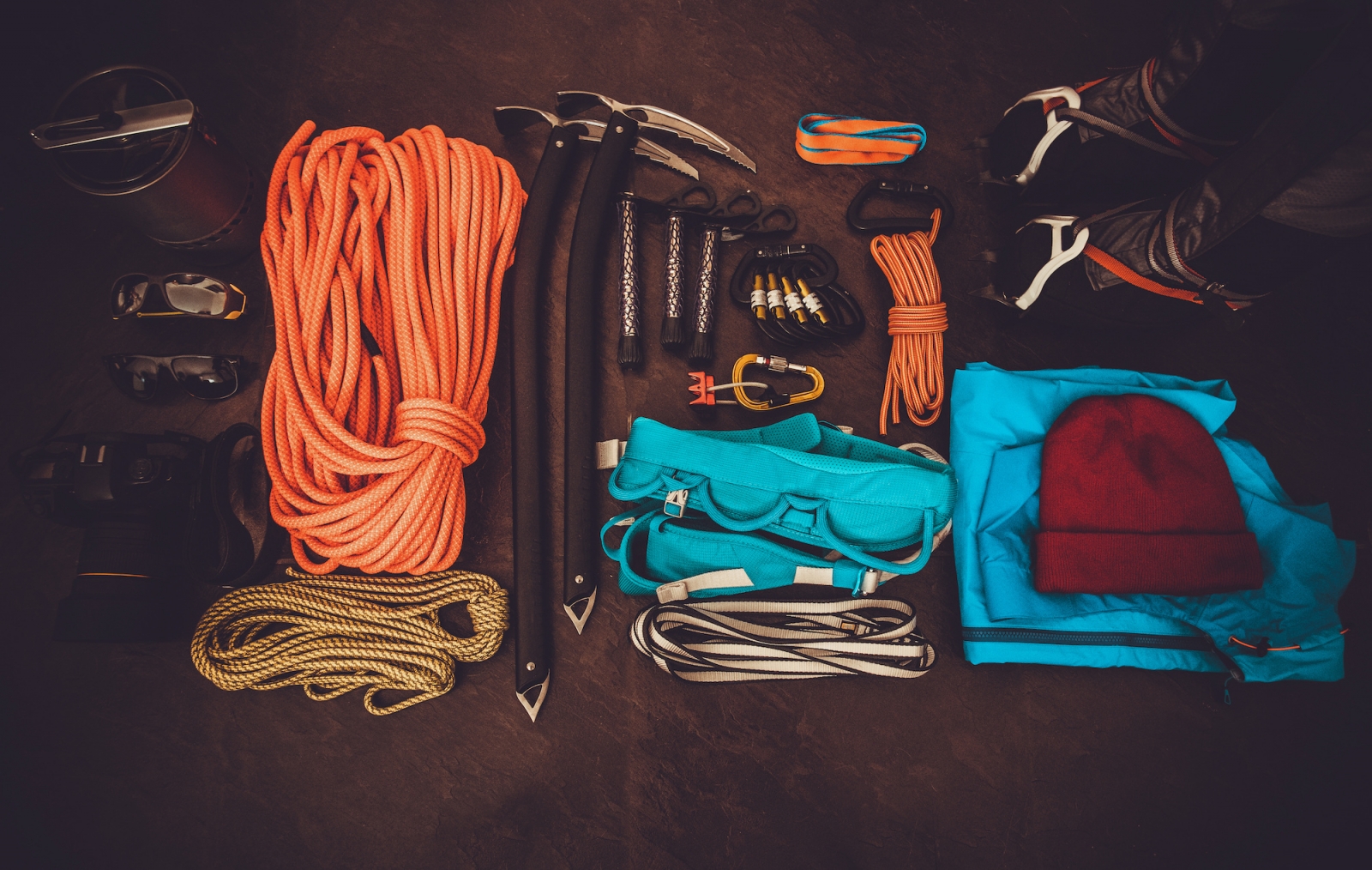
It's also important to note that some of this equipment may be available for rent in Bhutan. Tourists should consult with their licensed local guide or a reputable mountain climbing outfitter to determine what equipment is necessary and what can be rented locally.
Yes, it's important for tourists who are planning to go mountain climbing in Bhutan to have appropriate insurance coverage. Travel insurance can provide coverage for unexpected events such as accidents, illness, trip cancellation or interruption, emergency medical expenses, and evacuation. When selecting travel insurance for mountain climbing in Bhutan, tourists should ensure that the policy covers high-altitude mountaineering and any other activities they plan to engage in. They should also ensure that the policy covers the full cost of emergency medical treatment and evacuation, which can be quite expensive.
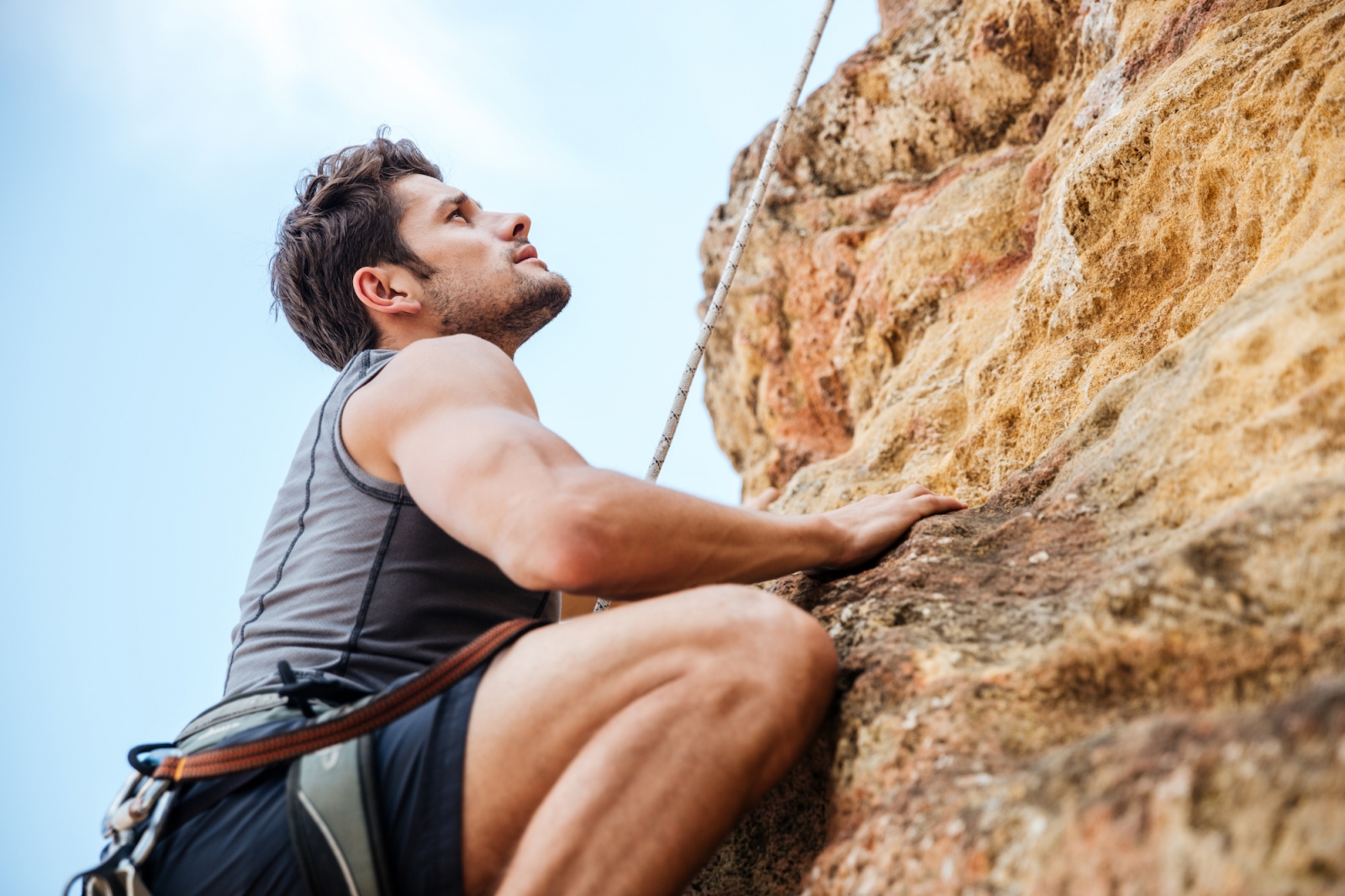
It's important to carefully read and understand the terms and conditions of the insurance policy before purchasing it to ensure that it meets the specific needs of the trip. Tourists should also keep a copy of the insurance policy and emergency contact information with them at all times during the trip. In addition to travel insurance, tourists should also ensure that they have adequate health insurance coverage for any pre-existing medical conditions they may have. They should consult with their health insurance provider to understand what medical services are covered abroad and what out-of-pocket expenses they may be responsible for.
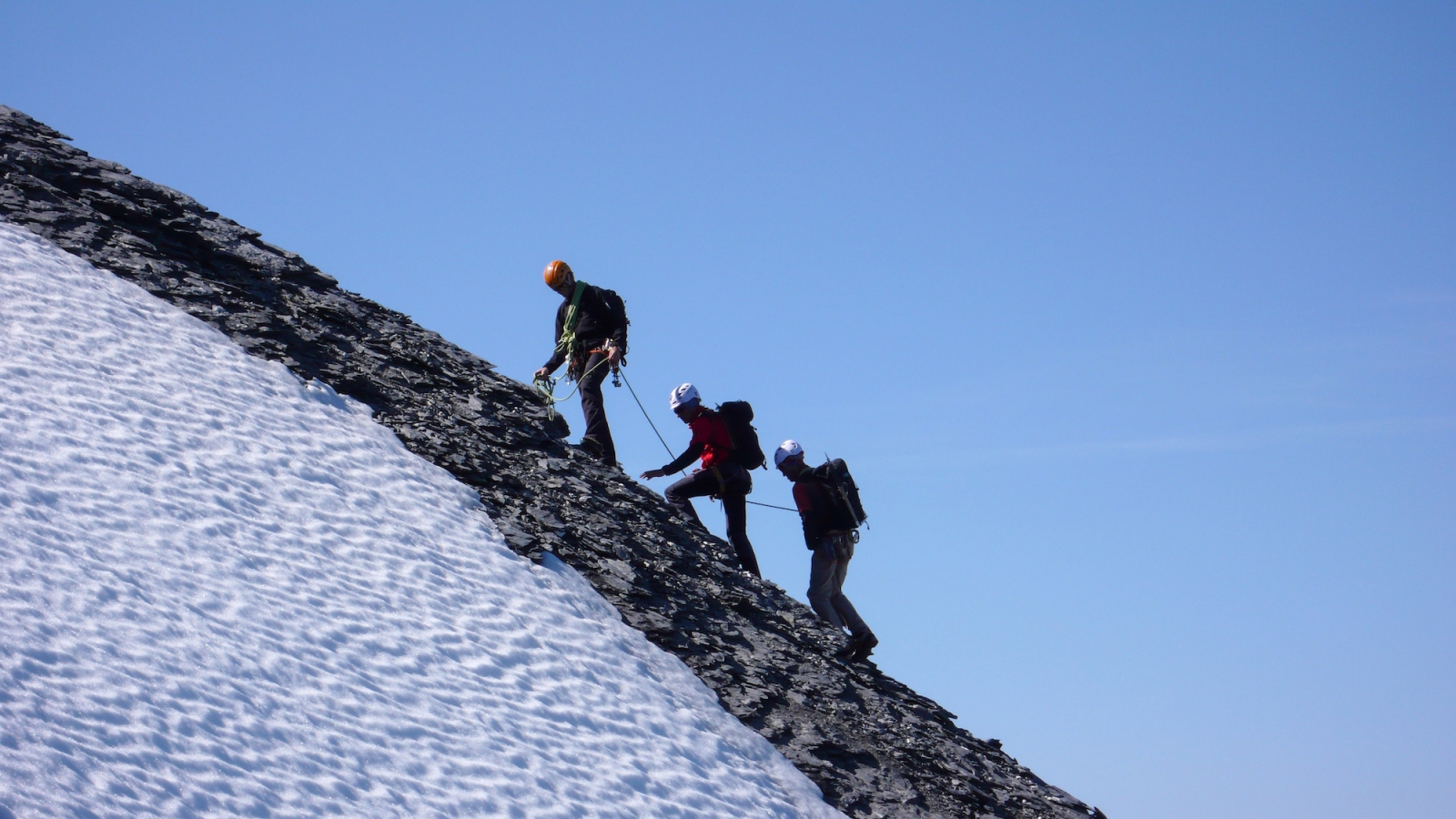
An experienced mountain guide and two clients are heading up to a high mountain peak and reaching the top under a blue sky in Bhutan
Read our previous article Souvenirs from China
Read our next article Souvenirs from the USA and Thailand










